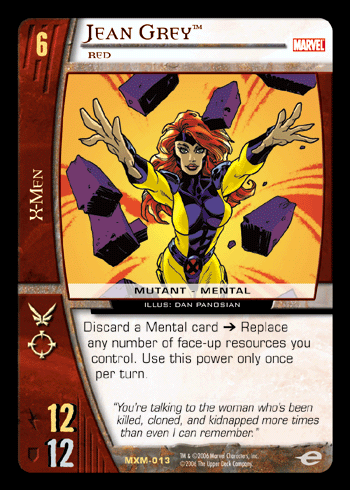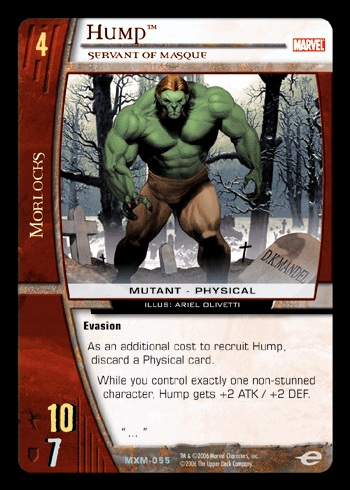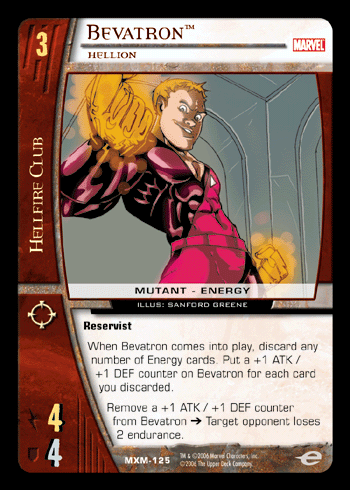
Welcome to the beginning of year three for Vs. System. It seems like just yesterday that I was writing my first preview article for Marvel Origins; time flies when you’re having fun. I guess it’s only fitting that we go back to where it all started with the X-Men. Last time I wrote one of these first-spoiler-of-the-set articles, I gave in and put the spoiler at the top of the article. This time, I’m going to make you work for it.
Hopefully by now, everyone knows about the new Silver Age tournament format. If not, be sure to check out David Humpherys’s Metagame.com article here. We’ve been planning for this format for quite some time, and one of the first points of discussion R&D tackled was how to keep certain teams perpetually in the Silver Age format.
We knew that we wanted to continue to introduce new teams, but at the same time, we didn’t want certain fan favorites to cycle out of the format for too long. Ultimately, we decided on a direction that would ensure that one of those core teams would never be out of the Silver Age format for more than a year.
Player feedback, tournament results, recent storylines (House of M), and the upcoming X3 movie made the X-Men and Brotherhood teams clear choices to be brought back into the format. After locking down that decision, the natural next step was to theme the entire expansion around Marvel mutants. We choose to introduce the Morlocks and the Hellfire Club as the two new teams for the set.
When I was working with the R&D group on the original card pool for Marvel Origins, we spent a couple hours talking about the possibility of having appropriate referent words on the characters—keywords like mutant, hero, villain, alien, and mystic. We knew that adding these traits to characters could expand future design space, but at that time, we raised more questions than we did answers. We knew that in the first set, we wanted players learning the basics of game play, so that meant we’d either need to create mechanics for these traits (which meant more game rules), or we’d need to have card effects that interacted with them (which led to problems of how many we introduced), or we’d have to ignore them in the first set and introduce mechanics and effects in later expansions (which would have had players learning game terms that served no function at the time).
We also had other concerns, such as deciding how many referents to put on the characters, and whether we could reasonably come up with the majority of terms we’d ever want to include in the game. There was also the issue of where these referents would appear on the card; if it were inside the text box, they would turn off when the character was stunned. Ultimately, we choose not to put them on characters, though in later sets, many of the new keywords (such as willpower, leader, and ally) filled this role.
It was the right decision at the time, but I was always a little sad that the mutant characters in Marvel Origins didn’t have a unique feel to them that went outside of their team identities. When we decided that all the teams in the X-Men set were going to be mutants, I knew I was being given a second opportunity to expand what it meant to be a mutant within the game.
As is typical for me during early design, I began with some out-of-the-box ideas about how to introduce the mutant concept into the game. I first looked at what it meant within the context of the property. Mutation is change; the concept is captured in the comics and movies as the next step forward in human evolution. All modern mutants have a dramatic moment in their adolescent lives when their mutant powers first emerge.
This led me to explore how characters could change or mutate during the game. In the past, we designed growth-over-time characters with accompanying support cards that helped these characters survive through the early turns. This was one of the core mechanical identities for the Thunderbolts team. I quickly abandoned this direction for two reasons. In a typical comic issue, mutants are no longer changing. Most of them have interesting back-stories about when they first displayed their mutant powers, and there have been storylines with secondary mutations (poor Beast), but it’s something that typically happens off-camera. So, it didn’t make much sense for them to be mutating over the course of the game. The second reason was the tracking component. To change a character from one state to another requires a method to trigger the change and a clean way to show how the character is different after the transformation. I came up with a number of interesting mechanics to support this, but the changing process became the primary focus of the character. It left little room for the traditional character effects that we use to support team identity.
My next direction had me thinking about the different types of mutations and whether they lent themselves to natural groupings of similar powers. I’ve been playing superhero role-playing games for years, and I collected action figures long before that. Looking at the listing of power types in these books and the power bar ratings on the backs of packaging (intelligence, strength, speed, durability, energy projection, fighting skills . . . anyone?), I knew this was something familiar to comic fans and gamers that I could incorporate into the new mechanics for the set.
I looked at the different classic power categories and started exploring how many mutation types would be correct for the game. I needed to pick categories that were broad enough that each team of mutants could reasonably have a few members with powers from that category. For example, the Speedster archetype was very common in many role-playing games, but there are less than half a dozen named mutant Speedsters in the Marvel universe. Looking at the options, I finally decided to combine the classic categories of the Brick and Martial Artist into what would become the Physical Mutation trait; Blasters and Energy Manipulators into the Energy Mutation trait; and Telepaths, Telekinetics, and Psychics into the Mental Mutation trait.
These three categories seem to be the classic trinity of the superhero genre, much the same way that Fighter, Mage, and Priest are the standard for the fantasy genre. Reviewing these choices against early character lists for the teams showed a fairly balanced distribution across the three categories.
Now that I had the different mutation categories, I needed to figure out how they would be integrated into game play. Again, the designer in me took over and I worked on creating unique game mechanics for each of the mutation categories. Reviewing these preliminary mutation rules, the development team made the following observations. Since each of the teams had a mix of characters across the different mutant categories, the new mechanics put a lot of stress on the standardized game text that was being used to create team identities. In a Sealed Pack environment, it was difficult to understand the value of a character, as mutation abilities sometimes worked on a completely different axis from a character’s game text effect. I knew I wanted to see viable dual- and tri-mutation decks across all formats, but separate mutation mechanics typically led either to mono-mutation decks or mixed-mutation decks that had no real cohesion.
The next evolution in trait design was to link each of the mutation traits with a series of standardized effects that were common to most Vs. games—effects like ATK / DEF bonuses and negatives, can’t be stunned while attacking, reinforcement, direct endurance loss, card draw, deck searching, exhausting characters, recovery, and movement. This approach allowed each trait category to have its own distinct feel while at the same time allowing it to work along the same axis as normal game text mechanics.
Dave Humpherys has a standardized game effects file that he has been adding to since the very first set. Using that file, the development team reviewed each game effect and determined which mutation trait it should fall under. The traits themselves provided the handholds we needed to determine which effects were assigned to those traits. The Physical trait wanted combat-intensive effects like ATK pumps; the Energy trait wanted to interact directly with endurance and altering characters outside of combat (exhaustion, movement, range); and Mental naturally aligned to deck, hand, and resource row manipulation, along with restricting the normal actions a character could take (interfering with control, breakthrough, and reinforcement).
This ended up being the mechanical Holy Grail that gave me everything I wanted in deck construction. Players could run a standard team or a multi-team deck (ignoring mutation), a mono-mutation/multi-team deck, a multi-mutation/mono-team deck, or any combination using traits and team affiliations. I also found it valuable to have game effects that could reference and interact with Mutants outside of their specific mutation trait. This led to the final presentation of the traits to appear as Mutant – Physical, Mutant – Energy, and Mutant – Mental.
You’ll notice that throughout the article, I’ve referenced Mutant as a trait and not as a keyword. So, what does this mean? In the past, when we’ve created referent keywords inside the text box of a card, we had to “turn off” those effects when the character was stunned or in certain other game zones. Much like team affiliations, we wanted Mutants to continue being Mutants even when they were stunned. This meant we either needed to rewrite how keywords worked, or we needed to put this information outside the game text box and create a new term for it (trait). Not wanting to burden players with having to learn new rules for keywords, we opted to put the trait outside the text box. Graphically, we came up with this:



I figured that since I made you wait so long before getting to the spoiler, I’d throw in two extra spoiler cards. Actually, I wanted to show off each of the different mutation traits and the types of mechanics players can expect from each of the categories. Before I briefly talk about each of the cards above, let’s review the official boxtopper rules for Mutants and traits:
Not every character in this set is a Mutant, but non-Mutant characters have ways of becoming Mutants, and a Mutant can gain traits in addition to its printed one. Note that characters introduced in earlier sets do not retroactively become Mutants.
As the boxtopper explains, the X-Men and Brotherhood characters from the first set do not automatically become Mutants with the new trait rules. We could have errata’d all those cards and given them the appropriate trait, but that would have been far too much information for players to have to memorize.
Also mentioned were the facts that non-Mutants can become Mutants, and Mutants can gain additional traits beyond their printed one. The way we designed the trait mechanics, it was much easier for us to give characters new Mutant traits than it was, for example, for us to give non-willpower characters a willpower rating. As future spoilers will reveal, we were able to create trait-based Team-Up cards that allowed for Mutant teams to combine with non-Mutant teams and share both team affiliations and mutation traits. This means that if you want to fill out your old X-Men or Brotherhood decks with cards from the new set (or vice versa) and run a mutation trait strategy, you can!
Jean Grey got a sizable boost from her Origins version. No longer limited to replacing a single resource, she can now replace all your face-up resources at the cost of a Mental discard. Her power showcases the manipulation element of the Mental trait. While strongest in a pure Mental deck where her power’s cost is a fairly insignificant price, she’s also a pretty safe bet in a pure X-Men deck, which has more Mental characters than any other team in the set.
Hump is your classic Brick character (when he’s not busy designing games) and will smash through your opponent’s defenses with his powerhouse ATK rating. Hump is more heavily trait-stamped than Jean; he requires his controller to commit to a healthy number of Physical characters in the deck before he is willing to hit the board and smash heads. Future spoiler articles will go into more detail about the Morlock mechanical identities, but you can see from Hump that many of them will have the evasion keyword and powers that look for the number of stunned characters you control. Proactively determining the correct attack order or reactively using the evasion ability with your other characters will allow Hump to grow to a 12 ATK / 9 DEF behemoth (sorry, Feral Rage). It doesn’t get much more Physical than that.
Bevatron showcases how decks can be built around mutation traits instead of (or in addition to) the classic team build model. With a single Energy discard, he’s bigger than most other 3-drops in the game. If he’s getting stunned and you know he’s about to leave play for good, you can burn your opponent directly on the way out. Direct endurance loss is one of the hallmark effects of the Energy trait.
I want to review one last issue before showing off the artwork for the next spoiler. Dual-affiliated characters were a huge hit in the JLA set. R&D loves this mechanic, as it more naturally allows us to integrate legacy characters into Sealed Pack formats. However, there was serious consideration about whether we’d put dual-affiliated characters into the X-Men set, because the graphical presentation we chose for dual affiliations directly competed against the art space that was being limited by the mutation trait bar. This means that you won’t find dual-affiliated characters in the X-Men set with the same mechanics as those presented in JLA. (But you’ll still find characters gaining multiple affiliations from card text and Team-Up effects.) The good news is that dual-affiliated characters will become a standard in future Vs. expansions, much the same way as the boost and concealed keywords appeared in all sets after they were introduced. Additionally, all future Mutant characters will have the trait bar. Our graphics team recently (sadly, two months after R&D turned over the X-Men file) created a new card template that allows for both dual-affiliation and mutation traits without competing for art space. Look for these cards in the Heralds of Galactus expansion releasing later this year.

Tomorrow's Preview: